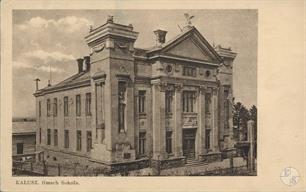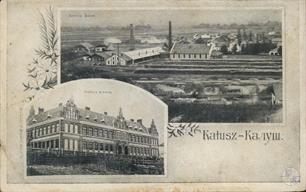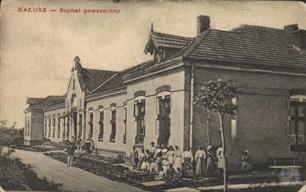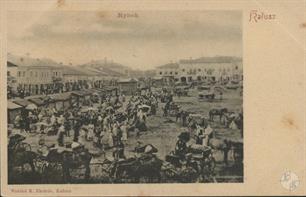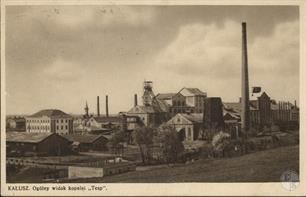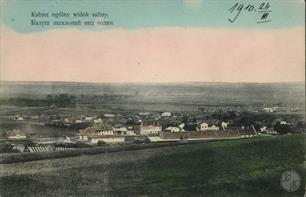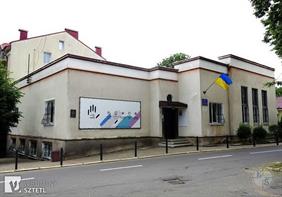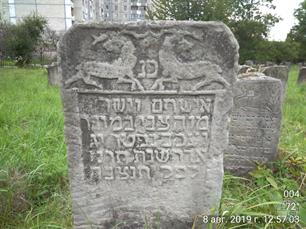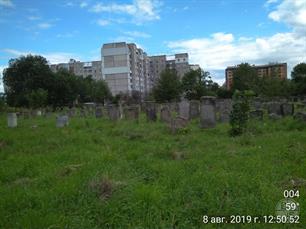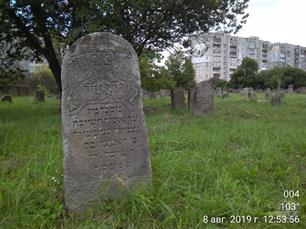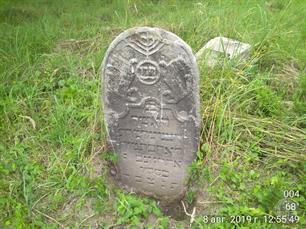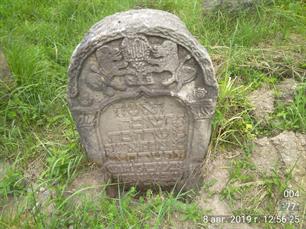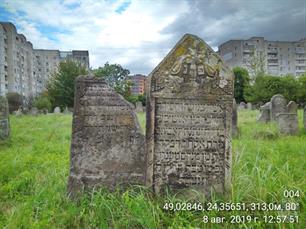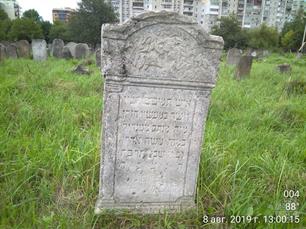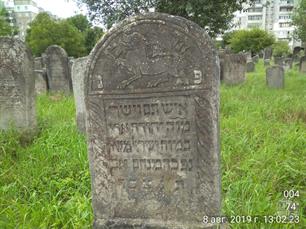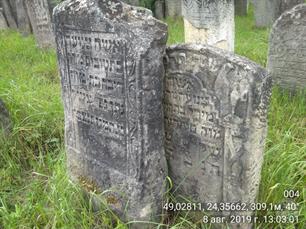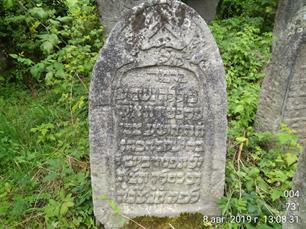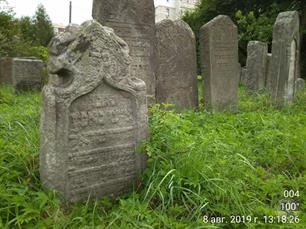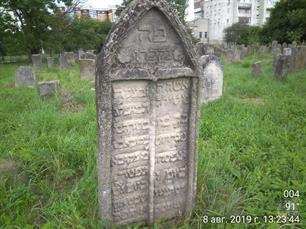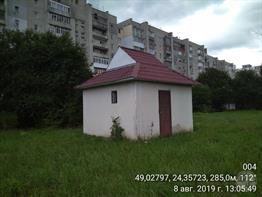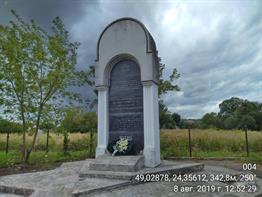Kalush
Sources:
- Russian Jewish encyclopedia
- Virtual Shtetl. Kalush
Photo:
- Jewish Cemeteries Initiative. Kalush Jewish Cemetery
- Vladimir Levin, Center for Jewish art
- Biblioteka Narodowa Polona. Kalush
- Virtual Shtetl. Synagoga w Kałuszu
- Russian Jewish encyclopedia
- Virtual Shtetl. Kalush
Photo:
- Jewish Cemeteries Initiative. Kalush Jewish Cemetery
- Vladimir Levin, Center for Jewish art
- Biblioteka Narodowa Polona. Kalush
- Virtual Shtetl. Synagoga w Kałuszu
Kalush district, Ivano-Frankivsk region
Kalush, city (since 1939), district center in the Ivano-Frankivsk region. Known from 1241. In 1549 received Magdeburg law. In the 16-18 centuries - in the Russian Voivodeship as part of the Commonwealth. In 19 - beginning of the 20 centuries is a city, the center of the province of Galicia as part of Austria-Hungary. In 1919–39 - in the Stanislav Voivodeship as part of Poland, in 1939–91 - as part of the Ukrainian SSR.
In 1765, 1662 Jews lived in Kalush,
in 1880 - 4267 (59.2%),
in 1900 - 4323 (55%),
in 1921 - 3121 (47.5%),
in 1931 - 3967,
in 1937 - approx. 6000 Jews.
In 1765, 1662 Jews lived in Kalush,
in 1880 - 4267 (59.2%),
in 1900 - 4323 (55%),
in 1921 - 3121 (47.5%),
in 1931 - 3967,
in 1937 - approx. 6000 Jews.
The first Jewish families appeared in Kalush ca. 1600. The Jewish district was called “The Little Palestine.” It had all the characteristics of a Jewish shtetl.
From the 16th century Jews rented salt mines in Kalush.
In the 2nd half of the 17th century, a community was created in Kalush.
In 1765 they owned 135 houses.
In 1825, the Jewish community built the so-called Great Synagogue in the town’s centre (according to information from the old inhabitants of the town, it was located at the site of the current Prykarpatsky Hotel).
There were five synagogues in the town, providing services to 6,000 “sons and daughters of Israel”: one large and four smaller. A hundred years later, there were 7,210 inhabitants in the town, including 4,266 Jews.
One of the first rabbis of Kalush was Benjamin Rapoport (1698–1771), in 1791–1809 - Yakov Lorberboym (1770–1832, Stry).
The rabbis of Kalush in the 1830s were Ts vi-Girsh Teumim and Menachem-Mendl Stern, in 1852-54 - Tsvi-Girsh Hayus, in the 1870s - Shimon Orenstein.
In the 18th century, the ideas of Hasidism in the city preached Dovid Laifer and his nephew Izhok (1770–1840).
In the 19th century, the Khasid court in Kalush was founded by Isroel Maer (1800–1880), then the dynasty was led by his son Itshok (1848–1940) and grandson Isroel Montzon (1880–1957, New York).
From the 16th century Jews rented salt mines in Kalush.
In the 2nd half of the 17th century, a community was created in Kalush.
In 1765 they owned 135 houses.
In 1825, the Jewish community built the so-called Great Synagogue in the town’s centre (according to information from the old inhabitants of the town, it was located at the site of the current Prykarpatsky Hotel).
There were five synagogues in the town, providing services to 6,000 “sons and daughters of Israel”: one large and four smaller. A hundred years later, there were 7,210 inhabitants in the town, including 4,266 Jews.
One of the first rabbis of Kalush was Benjamin Rapoport (1698–1771), in 1791–1809 - Yakov Lorberboym (1770–1832, Stry).
The rabbis of Kalush in the 1830s were Ts vi-Girsh Teumim and Menachem-Mendl Stern, in 1852-54 - Tsvi-Girsh Hayus, in the 1870s - Shimon Orenstein.
In the 18th century, the ideas of Hasidism in the city preached Dovid Laifer and his nephew Izhok (1770–1840).
In the 19th century, the Khasid court in Kalush was founded by Isroel Maer (1800–1880), then the dynasty was led by his son Itshok (1848–1940) and grandson Isroel Montzon (1880–1957, New York).
On July 2, 1941, the Wehrmacht detachments occupied Kalush. In July 1941, Judenrat was created, later - the ghetto.
At the end of August 1941, about 380 Jews were shot, in September - approx. 50.
In July 1942, more than 200 Jewish families from the surrounding settlements were relocated to Kalush.
In the fall of 1942, Jews from Kalush were deported to Stanislav (Ivano-Frankivsk) and shot there.
In total, 3 families were saved.
In 1945, the Jews who returned from the army and evacuation left Kalush, leaving for Poland.
In 2002, a community was created in Kalush. At that time, OK lived in the city. 100 Jews
Yakov Avovich Campelmaker, surgeon, Dr. Medical Sciences (1957) was born in Kalush.
At the end of August 1941, about 380 Jews were shot, in September - approx. 50.
In July 1942, more than 200 Jewish families from the surrounding settlements were relocated to Kalush.
In the fall of 1942, Jews from Kalush were deported to Stanislav (Ivano-Frankivsk) and shot there.
In total, 3 families were saved.
In 1945, the Jews who returned from the army and evacuation left Kalush, leaving for Poland.
In 2002, a community was created in Kalush. At that time, OK lived in the city. 100 Jews
Yakov Avovich Campelmaker, surgeon, Dr. Medical Sciences (1957) was born in Kalush.
In 1914, during World War I, the Russians burned 200 Jewish houses – the whole centre of Kalush.
At that time, a pogrom occurred in the city, arranged by the Cossack units of the Russian army.
In 1916, 30 Jews were sent from Kalush to Tarnopol.
In 1918, many Jews joined the local militia – the Jewish Kalush Brigade – which protected houses and shops and ensured peace in the evening.
Under the West Ukrainian People’s Republic (1918–1919), the Jewish National Councils representing local Jewish communities were active in Kalush District.
In 1919, natives of Kalush created community in the USA.
In 1920, the cavalry units of the Red Army in the city were taught the pogrom.
In 1928, a credit bank was opened with the help of Joint.
In the 1920-30s. There were separations of various Jewish parties and organizations.
In 1910-30, the rabbi in Kalush was Josef Babad (1875, Hollarors - 1943, Manchester, Great Britain).
In 1931, 5,109 Jews lived in Kalush District. In 1937, the town itself had 14,700 inhabitants, including 6,000 Jews.
At that time, a pogrom occurred in the city, arranged by the Cossack units of the Russian army.
In 1916, 30 Jews were sent from Kalush to Tarnopol.
In 1918, many Jews joined the local militia – the Jewish Kalush Brigade – which protected houses and shops and ensured peace in the evening.
Under the West Ukrainian People’s Republic (1918–1919), the Jewish National Councils representing local Jewish communities were active in Kalush District.
In 1919, natives of Kalush created community in the USA.
In 1920, the cavalry units of the Red Army in the city were taught the pogrom.
In 1928, a credit bank was opened with the help of Joint.
In the 1920-30s. There were separations of various Jewish parties and organizations.
In 1910-30, the rabbi in Kalush was Josef Babad (1875, Hollarors - 1943, Manchester, Great Britain).
In 1931, 5,109 Jews lived in Kalush District. In 1937, the town itself had 14,700 inhabitants, including 6,000 Jews.
In the 19th century, the Jewish community of Kalush, like most communities in Galicia, was divided into three major groups – Orthodox Jews, Hasidim, and Progressive Jews (Haskalah). Most of the local Jewish population was Orthodox.
In 1910, 8,000 people lived in the town. Half of them were Jews.
A Jewish lower secondary school was opened; one of the teachers working there in 1911 was P. Paluszyński.
Since 1895, the Zionist organization "Zion" operated in Kalush.
In 1900 in the city there were 6 synagogues; Common taxes paid 600 Jews.
In 1905, the Safa Brura school was opened in K. with teaching in Hebrew, in 1911 - the school "Tushia".
In the early 1910s in the Polish gymnasium, half of the students were Jews.
In 1912, the trade union of Jews - construction workers was organized in Kalush.
In 1910, 8,000 people lived in the town. Half of them were Jews.
A Jewish lower secondary school was opened; one of the teachers working there in 1911 was P. Paluszyński.
Since 1895, the Zionist organization "Zion" operated in Kalush.
In 1900 in the city there were 6 synagogues; Common taxes paid 600 Jews.
In 1905, the Safa Brura school was opened in K. with teaching in Hebrew, in 1911 - the school "Tushia".
In the early 1910s in the Polish gymnasium, half of the students were Jews.
In 1912, the trade union of Jews - construction workers was organized in Kalush.

- Home
- Shtetls
- Vinnytsia region
- Volyn region
- Dnipro region
- Donetsk region
- Zhytomyr region
- Zakarpattia region
- Zaporizhzhia region
- Ivano-Frankivsk region
- Kyiv region
- Kropyvnytskyi region
- Luhansk region
- Lviv region
- Mykolayiv region
- Odessa region
- Poltava region
- Rivne region
- Sumy region
- Ternopil region
- Kharkiv region
- Kherson region
- Khmelnytskyi region
- Chernihiv region
- Chernivtsi region
- Cherkasy region
- Crimea
- Synagogues
- Cemeteries
- Objects & guides
- Old photos
- History
- Contact
Jewish towns of Ukraine
Jewish towns of Ukraine
My shtetl
My shtetl
Donate
